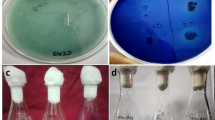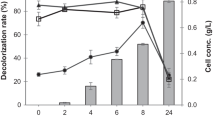Abstract
Textile industry waste has become one of the largest polluters in the world. In recent years, there has been a growing awareness of the need for sustainable and eco-friendly practices for the treatment of dye-laden effluents. Overall, this study highlights the potential of bioremediation as a sustainable solution for wastewater treatment. The Bacillus mojavensis isolated from wastewater and identified using 16S rRNA degraded reactive yellow 145 and methyl orange in 36 h of incubation, this decolorization was affected by pH, temperature, dye concentration, glucose concentration, source of nitrogen, type of dye, and agitation. Our study found that the optimal conditions for total decolorization of dyes were achieved by incubating B. mojavensis at 46 °C, pH 9, with 1 g/L of glucose and 2 g/L of peptone. The azoreductase activity, FT-IR analysis, and UV–visible spectrum before and after total decolorization indicated that it was a dye degradation rather than biosorption in surface Celle. In addition, the study of phytotoxicity show the metabolites of degradation are not phytotoxic in Lens esculenta seeds. In conclusion, our results suggest the use of this bacterium as an environmentally friendly and also cost-effective method, making it an attractive option for industries looking to reduce their environmental impact.





Similar content being viewed by others
Data Availability
Not applicable.
References
Mohan SV, Rao CN, Prasad KK, Karthikeyan J (2002) Treatment of simulated reactive yellow 22 (azo) dye effluents using Spirogyra species. Waste Manage 22:575–582
Al-Tohamy R, Ali SS, Li F, Okasha KM, Mahmoud YA, Elsamahy T, Jiao H, Fu Y, Sun J (2022) Critical review on the treatment of dye-containing wastewater: ecotoxicological and health concerns of textile dyes and possible remediation approaches for environmental safety. Ecotoxicol Environ Saf. https://doi.org/10.1016/j.ecoenv.2021.113160
Naresh B, Jaydip J, Prabhat B, Rajkumar P (2013) Recent biological technologies for textile effluent treatment. Int Res J Biol Sci 2(6):77–82
Mortadi A, Chahid EG, Elmelouky A, Chahbi M, Ghyati NE, Zaim S, Cherkaoui O, El Moznine R (2020) Complex electrical conductivity as a new technique to monitor the coagulation-flocculation processes in the wastewater treatment of the textile industry. Water Resources Ind 24:100130. https://doi.org/10.1016/j.wri.2020.100130
Holkar CR, Jadhav AJ, Pinjari DV, Mahamuni NM, Pandit AB (2016) A critical review on textile wastewater treatments: possible approaches. J Environ Manage 182:351–366. https://doi.org/10.1016/j.jenvman.2016.07.090
Achour Y, Bahsis L, Ablouh EH, Yazid H, Laamari MR, El Haddad M (2021) Insight into adsorption mechanism of congo red dye onto bombax buonopozense bark activated-carbon using central composite design and DFT studies. Surf Interfaces. https://doi.org/10.1016/j.surfin.2021.100977
El Kassimi A, Achour Y, El Himri M, Laamari R, El Haddad M (2021) Removal of two cationic dyes from aqueous solutions by adsorption onto local clay: experimental and theoretical study using DFT method. Int J Environ Anal Chem. https://doi.org/10.1080/03067319.2021.1873306
Saravanan P, Josephraj J, Thillainayagam BP (2021) A comprehensive analysis of biosorptive removal of basic dyes by different biosorbents. Environ Nanotechnol Monit Manage. https://doi.org/10.1016/j.enmm.2021.100560
Solis M, Solis A, Perez HI, Manjarrez N, Flores M (2012) Microbial decolouration of azo dyes: a review. Process Biochem 47:1723–1748
Wang H, Su JQ, Zheng XW, Tian Y, Xiong XJ, Zheng TL (2009) Bacterial decolorization and degradation of the reactive red 180 by Citrobacter sp. CK3. Int Biodeterior Biodegrad 63:395–399
Chen G, Huang M, Chen L, Chen D (2011) A batch decolorization and kinetic study of reactive Black 5 by a bacterial strain Enterobacter sp. GY-1. Int Biodeterior Biodegrad 65(6):790–796. https://doi.org/10.1016/j.ibiod.2011.05.003
Khan S, Abdul M (2015) Degradation of reactive Black 5 dye by a newly isolated bacterium Pseudomonas entomophila BS1. Can J Microbiol 62(3):220–232
Velusamy K, Periyasamy S, Kumar PS, Jayaraj T, Gokulakrishnan M, Keerthana P (2022) Transformation of aqueous methyl orange to green metabolites using bacterial strains isolated from textile industry effluent. Environ Technol Innov 25:102126
Al-Ansari MM, Li Z, Masood A, Rajaselvam J (2022) Decolorization of azo dye using a batch bioreactor by an indigenous bacterium Enterobacter aerogenes ES014 from the waste water dye effluent and toxicity analysis. Environ Res 205:112189. https://doi.org/10.1016/j.envres.2021.112189
Ameenudeen S, Unnikrishnan S, Ramalingam K (2021) Statistical optimization for the efficacious degradation of reactive azo dyes using Acinetobacter baumannii JC359. J Environ Manage 279:111512. https://doi.org/10.1016/j.jenvman.2020.111512
Garg N, Garg A, Mukherji S (2020) Eco-friendly decolorization and degradation of reactive yellow 145 textile dye by Pseudomonas aeruginosa and Thiosphaera pantotropha. J Environ Manage 263:110383
Sennaj R, Lemriss S, Souiri A, Kabbaj SE, Chafik A, Essamadi AK, Benali T, Fassouane A, Dari K, Aassila H (2023) Eco-friendly degradation of reactive red 195, reactive blue 214, and reactive yellow 145 by Klebsiella pneumoniae MW815592 isolated from textile waste. J Microbiol Methods 204:106659
Zheng JX (1996) A consistent test of functional form via nonparametric estimation techniques. J Econometr 75(2):263–289. https://doi.org/10.1016/0304-4076(95)01760-7
BLAST: basic local alignment search tool. Consulté le 25 décembre 2021. https://blast.ncbi.nlm.nih.gov/Blast.cgi
Flandrois JP, Perrière G, Gouy M (2015) leBIBIQBPP: a set of databases and a webtool for automatic phylogenetic analysis of prokaryotic sequence. BMC Bioinform. https://doi.org/10.1186/s12859-015-0692
Pruess E, Peplies J, Glöckner FO (2012) SINA: accurate high-throughput multiple sequence alignment of ribosomal RNA genes. Bioinformatics 28:1823–1829
Tamura K, Peterson D, Peterson N, Stecher G, Nei M, Kumar S (2011) MEGA5: molecular evolutionary genetics analysis using maximum likelihood, evolutionary distance, and maximum parsimony methods. Mol Biol Evolut 28:2731–2739
Saitou N, Nei M (1987) The neighbor-joining method: a new method for reconstructing phylogenetic trees. Mol Biol Evol 4(4):406–425
Felsenstein J (1985) Confidence limits on phylogenies: an approach using the bootstrap. Evolution 39:783–791
Moutaouakkil A, Zeroual Y, Dzayri FZ, Talbi M, Lee K, Blaghen M (2003) Purification and partial characterization of azoreductase from Enterobacter agglomerans. Arch Biochem Biophys 413:139–146
Zimmermann T, Kulla HG, Leisinger T (1982) Properties of purified Orange II azoreductase, the enzyme initiating azo dye degradation by Pseudomonas KF46. Eur J Biochem 129:197–203
Moutaouakkil A, Zeroual Y, Dzayri FZ, Talbi M, Lee K, Blaghen M (2004) Decolorization of azo dyes with Enterobacter agglomerans immobilized in different supports by using fluidized bed bioreactor. Curr Microbiol 48:124–129
Elizalde-González MP, Fuentes-Ramírez LE, Guevara-Villaa MRG (2009) Degradation of immobilized azo dyes by Klebsiella sp. UAP-b5 isolated from maize bioadsorbent. J Hazard Mater 161:769–774
Dimitris G, Tsoulos I, Dermatas E (2004) Feature selection for robust detection of distributed denial-of-service attacks using genetic algorithms. In: Vouros GA, Panayiotopoulos T (eds) Methods and applications of artificial intelligence lecture notes in computer science. Springer, Berlin, pp 276–281. https://doi.org/10.1007/978-3-540-24674-9_29
Logan NA, De Vos P (2009) Family Bacillaceae. In: Bergey’s manual of systematic bacteriology, vol 3. Springer, New York, p 20
Barathi S, Aruljothi KN, Karthik C, Padikasan IA, Ashokkumar V (2022) Biofilm mediated decolorization and degradation of reactive red 170 dye by the bacterial consortium isolated from the dyeing industry wastewater sediments. Chemosphere 286:131914
Sarioglu M, Bisgin T (2007) Removal of Maxilon Yellow GL in a mixed methanogenic anaerobic culture. Dyes Pigm 75:544–549
Kishor R, Purchase D, Saratale GD, Ferreira LF, Bilal M, Iqbal HM, Bharagava RN (2021) Environment friendly degradation and detoxification of congo red dye and textile industry wastewater by a newly isolated Bacillus Cohnni (RKS9). Environ Technol Innov 22:101425. https://doi.org/10.1016/j.eti.2021.101425
Sahasrabudhe M, Pathade GR (2011) Decolorization of C.I. reactive yellow 145 by Enterococcus Faecalis Strain YZ66. Arch Appl Sci Res 3:403–414
Chang JS, Kuo TS (2000) Kinetics of bacterial decolorization of azo dye with Escherichia coli NO3. Bioresour Technol 75(2):107–111
White D (1995) The physiology and biochemistry of Prokaryotes. Oxford University Press, New York
Akansha K, Chakraborty D, Ghosh SG (2019) Decolorization and degradation of methyl orange by Bacillus stratosphericus SCA1007. Biocatal Agric Biotechnol. https://doi.org/10.1016/j.bcab.2019.101044
Chen KC, Wu JY, Liou DJ, Hwang SCJ (2003) Decolorization of the textile dyes by newly isolated bacterial strains. J Biotechnol 101(1):57–68
Liu Y, Shao Z, Reng X, Zhou J, Qin W (2021) Dye-decolorization of a newly isolated strain Bacillus amyloliquefaciens W36. World J Microbiol Biotechnol 37:1–11
Kumar CG, Mongolla P, Joseph J, Sarma VUM (2012) Decolorization and biodegradation of triphenylmethane dye, brilliant green, by Aspergillus sp. isolated from Ladakh, India. Process Biochem 47:1388–1394
Gadow SI, Estrada AL, Li YY (2022) Characterization and potential of two different anaerobic mixed microflora for bioenergy recovery and decolorization of textile wastewater: effect of C/N ratio, dye concentration and Ph. Bioresour Technol Rep 17:100886
Salony, Mishra S, Bisaria VS (2006) Production and characterization of laccase from Cyathus bulleri and its use in decolourization of recalcitrant textile dyes. Appl Microbiol Biotechnol 71:646–653
Du LN, Li G, Zhao YH, Xu HK, Wang Y, Zhou Y, Wang Y (2015) Efficient metabolism of the azo dye methyl orange by Aeromonas sp strain DH-6: Characteristics and partial mechanism. Int Biodeterior Biodegrad 105:66–72
Prabhakar Y, Anshu G, Anubha K (2021) Using indigenous bacterial isolate Nesterenkonia lacusekhoensis for removal of azo dyes: a low-cost ecofriendly approach for bioremediation of textile wastewaters. Environ Dev Sustain. https://doi.org/10.1007/s10668-021-01661-0
Pourbabaee AA, Ramezani S, Javaheri DH (2013) Biodegradation of malachite green by Klebsiella Terrigenaptcc 1650: the critical parameters were optimized using Taguchi optimization method. J Bioremed Biodegrad 4:175. https://doi.org/10.4172/2155-6199.1000175
Singh AL, Chaudhary S, Kumar S, Kumar A, Singh A, Yadav A (2022) Biodegradation of reactive yellow-145 azo dye using bacterial consortium: a deterministic analysis based on degradable metabolite, phytotoxicity and genotoxicity study. Chemosphere 300:134504. https://doi.org/10.1016/j.chemosphere.2022.134504
Kishor R, Purchase D, Saratale GD, Ferreira LF, Hussain CM, Mulla SI, Bharagava RN (2021) Degradation mechanism and toxicity reduction of methyl orange dye by a newly isolated bacterium Pseudomonas aeruginosa MZ520730. J Water Process Eng 43:102300. https://doi.org/10.1016/j.jwpe.2021.102300
Author information
Authors and Affiliations
Contributions
Conceptualization, R.S., and H.A. methodology; R.S., K.D, M.T, and A.F; validation, R.S., H.A. M.T, and A.F; formal analysis, R.S., T.B., K.H and H.A; writing—original draft preparation, R.S., H.A. M.T, and T.B; supervision, H.A. All authors have read and agreed to the published version of the manuscript.
Corresponding author
Ethics declarations
Conflict of interest
The authors declare no conflict of interest.
Ethical Approval
Not applicable.
Informed Consent
Not applicable.
Additional information
Publisher's Note
Springer Nature remains neutral with regard to jurisdictional claims in published maps and institutional affiliations.
Rights and permissions
Springer Nature or its licensor (e.g. a society or other partner) holds exclusive rights to this article under a publishing agreement with the author(s) or other rightsholder(s); author self-archiving of the accepted manuscript version of this article is solely governed by the terms of such publishing agreement and applicable law.
About this article
Cite this article
Sennaj, R., Dari, K., Timinouni, M. et al. Evaluation of Bioremediation Potentiality of Bacillus mojavensis Isolated from Wastewater for the Elimination of Reactive Yellow 145 and Methyl Orange. Curr Microbiol 80, 326 (2023). https://doi.org/10.1007/s00284-023-03435-5
Received:
Accepted:
Published:
DOI: https://doi.org/10.1007/s00284-023-03435-5




